If there’s one good thing about confinement, it’s that it forces us to go outside more often for some fresh air. For many, the pandemic has been a powerful motivator to get moving… and socialize. Let’s hope that this healthy desire to be outdoors and go walking and biking lasts well beyond this crisis.
I’ve always envied the way Scandinavians live in harmony with their climate. While winter sometimes seems endless, I’d never want live under the sun year round. I love the changing seasons, I love the snow and I love skiing and cycling. Cross-country skiing is expected to be popular this winter – which is excellent news. I also predict that winter cycling will no longer be seen as the prerogative of eccentrics, but rather as a fast-growing sport that is here to stay. Obviously winter storms and deep freezes will require more motivation for getting on a bike. But then who said that cycling between December and March has to be a daily routine? It’s your choice! You can opt to ride when the roads are cleared, when the temperature suits you or when you can travel in complete safety. By dressing yourself properly, especially your head, hands and feet, you can create different outfits to make the most of winter biking. Like me, you’ll find that winter cycling is less chaotic than a season of cross-country skiing or skating, and more sensitive to the vagaries of the weather.
When I was a student at UQAM during the 80s, 3 or 4 of us used to go winter cycling… without snow-cleared bike paths. Then for several years, I rode until the first snowfall, stretching my cycling season as far into December as possible – and then got back on my bike in March. Today, the main breakthrough in terms of winter cycling is accessibility.
Take, for example, the EBN on St. Denis, Bellechasse, Rachel, Berri Streets and De Maisonneuve Blvd, as well as the new Samuel-de-Champlain and Jacques-Cartier Bridge, a first in the winter of 2021. These developments now provide Montréal cyclists with an increasingly attractive network for their daily commutes and will undoubtedly convince many to try out winter cycling this season.
The primary reason 80% of Copenhagen’s cyclists continue to travel by bike in winter is because their network is religiously cleared of snow – before 7 a.m. for the main routes! While Danish winters may not be as harsh as those in Québec, they still bring snow, cold and slush. The argument that building cycling infrastructure will attract more cyclists also holds true for bike path maintenance and snow clearing. This item is appearing more and more on municipal agendas which, in the current pandemic context, may well lead to a surprising increase in the number of winter biking enthusiasts. Who knows? Winter cycling may well become a new national “sport”.
Suzanne Lareau
President and CEO of Vélo Québec


